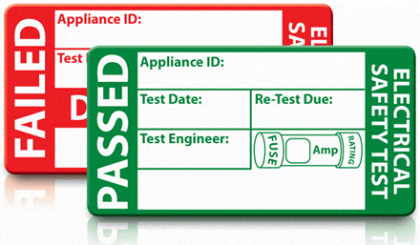 Portable Appliance Testing – known as PAT Testing – is the process of checking that electrical appliances are safe to use through a series of visual inspections and electronic tests. Its purpose is to prevent any electrical accidents in a workplace.
Portable Appliance Testing – known as PAT Testing – is the process of checking that electrical appliances are safe to use through a series of visual inspections and electronic tests. Its purpose is to prevent any electrical accidents in a workplace.
What does Portable Appliance Testing (PAT) involve?
The best way to ensure that your appliances are safe, is to carry out Portable Appliance Testing. Getting a qualified PAT Testing engineer in to carry out a visual inspection as well as a more in-depth check of your appliances, its plug and lead, will help you to ensure that they are safe to use.
Upon completion, you should receive a report from the inspector that details the following:
- A list of each appliance tested – its name, location, and description
- A full set of test results for each appliance tested (passed or failed)
- A full list of any failed items with an explanation of their failure
- A visible pass or fail label on each appliance detailing the inspection date, next test due and the inspector’s signature
What items should be PAT Tested?
There is no definition of what a ‘Portable Appliance’ is in the current legislation, however, the standard interpretation is “any appliance that has a plug attached to it and plugs into a wall socket needs PAT Testing” Because of this, the word ‘portable’ is a bit misleading.
There are 7 categories of appliance which should be considered for PAT testing:
- Fixed appliances – equipment which is fastened to a support, or fixed in a permanent location
- Stationary appliances – appliances such as fridges, washing machines, vending machines etc
- IT appliances – office equipment such as computers, monitors, printers and photocopiers
- Moveable appliances – Equipment under 18kg that sits in one place but can easily be moved around
- Portable appliances – Electrical items that are meant to be moved but are connected to an energy supply.
- Cables and chargers – Including extension leads
- Handheld appliances – Hair dryers and straighteners, electric drills etc.
Some examples of portable appliances are as follows:
- Fridges
- Phone Charges
- Dishwashers, Washing Machines, Tumble Dryers etc.
- Freezers
- Lamps
- TV’s
- Kettles
- Toasters
- Heaters
- Extension Leads
How often should I get my PAT Testing done?
There are no legal requirements for how often you should get your appliances PAT Tested, however here are a few things to help you consider how regular it should be:
- the risk level of the working environment
- the electrical class of the appliance
- the category of the appliance
The Health and Safety Executive also recommends taking the following into consideration as necessary:
- manufacturer’s recommendations
- the age of the equipment
- frequency of use
- foreseeable misuse of the equipment
- effects of any modifications or repairs
- the history of the item
How do I know if my appliance is faulty?
If you are a competent person and want to undertake PAT Testing yourself in your building but are unsure on what to check, here are some things to look out for when carrying out a visual inspection.
Is the cable split, damaged or twisted?
Does the packaging look authentic, does it look used at all?
Is the casing of the appliance cracked, warped, discoloured, scorched or burned?
Does the plug easily fit into a socket?
Can you hear, see or smell anything that is not normal when you plug it in? If the answer is yes, turn it off and unplug it straight away!
If you’re not sure that the equipment is safe to use, then it is best to stay on the safe side and not to use it at all. Electricity is a major cause of accidental fires in UK homes – over 20,000 each year and nine out of 10 (89%) electrical fires are caused by electrical products.
If the appliance is purchased from a retailer, then you are entitled to a refund, repair or replacement under the Consumer Rights Act.
